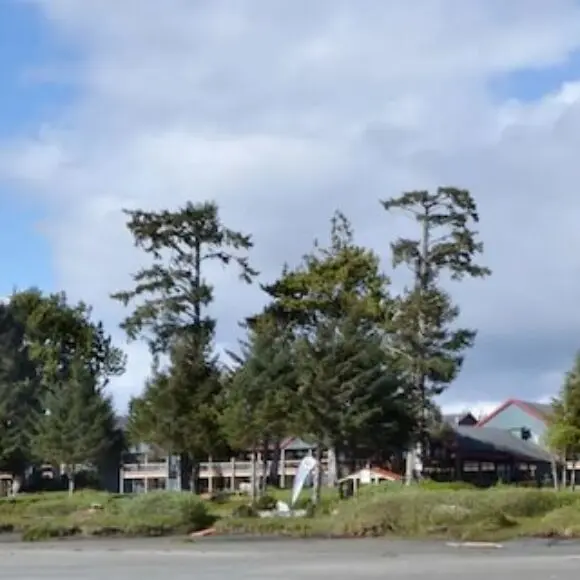Hotel Best Western Plus Tin Wis Resort

Best Western Plus Tin Wis Resort
Hotel Best Western Plus Tin Wis Resort reviews
Looking for a great place to stay in Tofino? Book Best Western Plus Tin Wis Resort; rated and is available from CAD $ 215. Best Western Plus Tin Wis Resort is conveniently located near ferry terminals, and can be booked directly with Trivago.
📍 Address Best Western Plus Tin Wis Resort
1119 Pacific Rim Highway, V0R 2Z0, Tofino, Canada
FAQ
How can I find the latest fare information for the ferry Vancouver sailing from Mayne Island (Village Bay) to Swartz Bay?
To find the latest fare information for the Vancouver Ferry sailing from Mayne Island (Village Bay) to Swartz Bay, it is best to check the Mayne Island to Swartz Bay fares page. Fares can vary depending on the time of year and the type of vehicle. This page offers up-to-date pricing details, ensuring you have the most accurate information before your trip.
What are the best times to travel from Swartz Bay on the ferry Vancouver to avoid peak traffic?
To avoid peak traffic when traveling from Swartz Bay on the ferry Vancouver, it’s recommended to travel during off-peak hours. Typically, early morning and late evening sailings tend to be less crowded. For more specific recommendations and to check the real time traffic, consult the Swartz Bay off-peak travel page. Traveling mid-week is also usually less busy than weekend travel.
Can I bring a bicycle on the ferry Vancouver from Denman Island (Hornby Island) to Buckley Bay?
Yes, bringing a bicycle on the ferry Vancouver from Denman Island (Hornby Island) to Buckley Bay is generally permitted. However, it’s advisable to review the specific guidelines and any potential restrictions by visiting the Denman to Buckley Bay bicycle transport page. Bicycles are typically boarded as foot passenger cargo, and it is best to arrive early.
Ferry Vancouver
Adventure sports enthusiasts use ferry services to transport kayaks, bicycles, and other outdoor equipment to Vancouver Island’s recreation destinations. Special handling procedures ensure equipment safety during transport. Vancouver Island offers world-class opportunities for surfing, hiking, cycling, and water sports accessible via ferry connections.
Multi-day Vancouver Island itineraries often begin with ferry travel from the mainland, allowing tourists to explore the island’s diverse regions. Popular destinations include Victoria’s Inner Harbour, Tofino’s surf beaches, and the wine regions of the Cowichan Valley. Ferry connections enable comprehensive island exploration combining urban and wilderness experiences.
Wildlife viewing opportunities during ferry crossings include orcas, seals, dolphins, and diverse seabird species throughout the Salish Sea. The best viewing occurs from outdoor decks, and crew members often announce wildlife sightings over the ship’s public address system. Binoculars enhance the wildlife watching experience during these scenic journeys.
Photography tips for ferry passengers include timing outdoor deck visits during optimal lighting conditions and bringing appropriate camera equipment for marine environments. Sunrise and sunset crossings provide particularly dramatic lighting opportunities. Zoom lenses help capture wildlife and distant mountain scenery during the journey.
Connecting transportation from ferry terminals includes public transit, rental cars, taxis, and ride-sharing services. Victoria’s Swartz Bay terminal connects to downtown Victoria via public bus service. Nanaimo terminals provide access to Island-wide transportation networks for exploring Vancouver Island’s diverse attractions and natural areas.
Accessibility features ensure all passengers can enjoy ferry travel, with elevators, wheelchair-accessible restrooms, and designated seating areas. Vehicles with accessibility equipment receive priority boarding assistance. Ferry staff provide support for passengers with mobility challenges throughout the journey.
Weather considerations can occasionally affect ferry schedules, particularly during severe winter storms or high winds. Safety remains the top priority, with sailings potentially delayed or cancelled during dangerous conditions. Passengers should monitor weather forecasts and sailing status before traveling, especially during winter months.
Vancouver Island ferry terminals feature modern amenities including restaurants, gift shops, and comfortable waiting areas. Tsawwassen and Swartz Bay terminals offer extensive facilities with multiple dining options, retail stores, and children’s play areas. Terminal locations provide convenient access to ground transportation, rental cars, and connecting bus services.
Horseshoe Bay to Departure Bay offers another major ferry route connecting West Vancouver to Nanaimo on Vancouver Island’s east coast. This scenic 100-minute crossing provides spectacular views of Howe Sound and the Coast Mountains. Nanaimo serves as an excellent gateway to explore central Vancouver Island, including access to Tofino, Cathedral Grove, and numerous outdoor recreation areas.
Fuel and vehicle services are available at some ferry terminals, allowing travelers to prepare for their Vancouver Island adventure. Terminal locations often feature gas stations, convenience stores, and automotive services. Pre-trip vehicle inspections ensure safe travel on Vancouver Island’s diverse road conditions.
Cultural experiences begin during ferry travel with onboard art displays featuring local Pacific Northwest artists. Indigenous cultural elements appear in vessel names, artwork, and interpretive displays. These features introduce visitors to the rich cultural heritage of Vancouver Island and coastal British Columbia.




